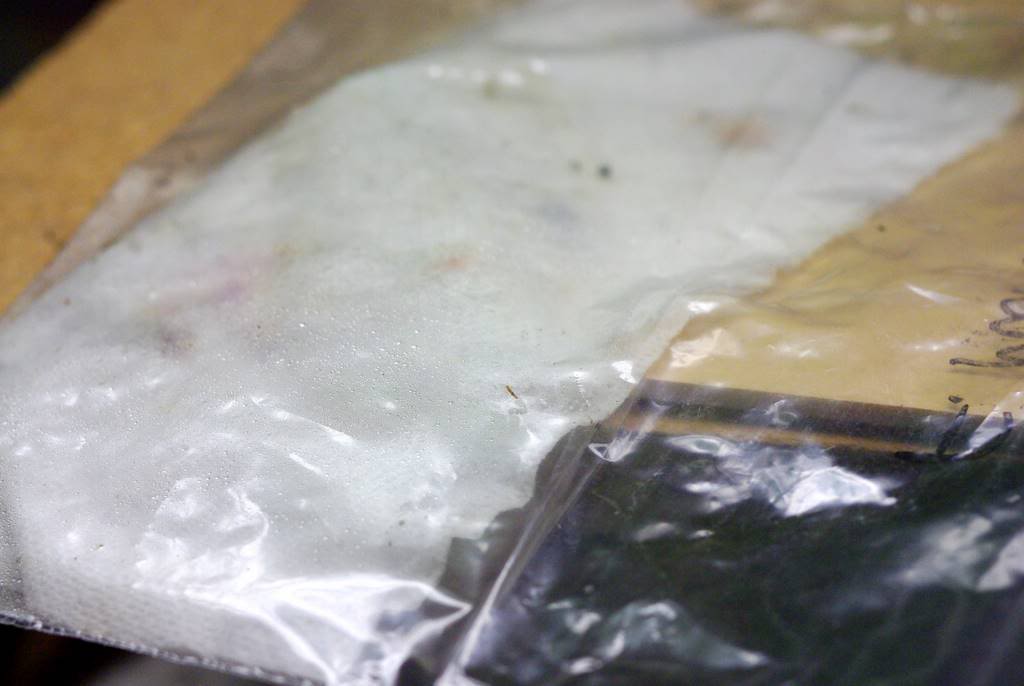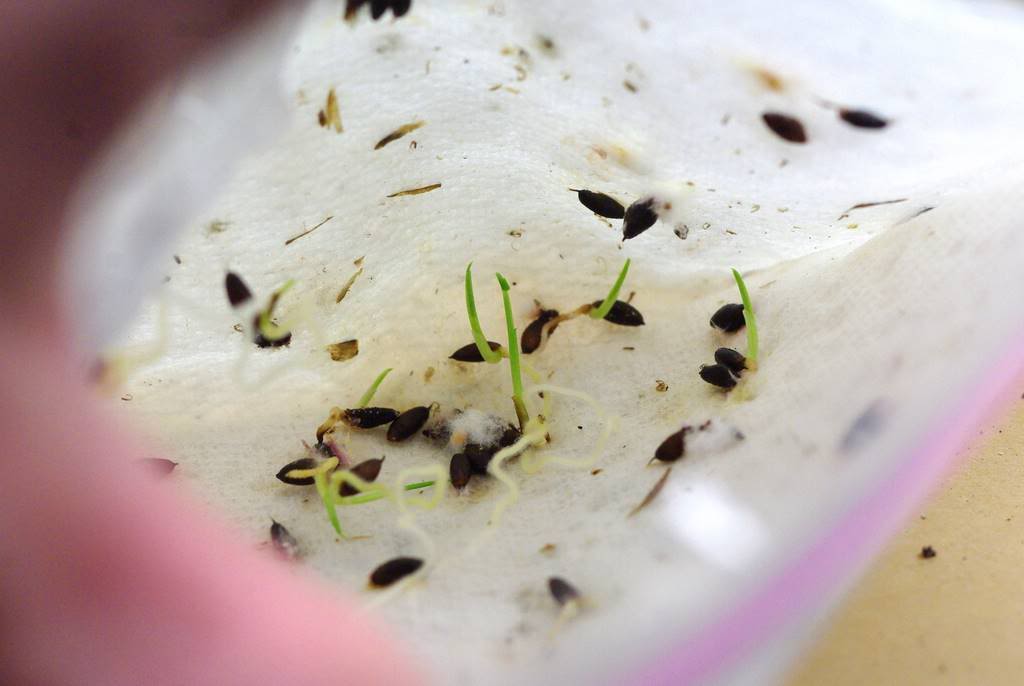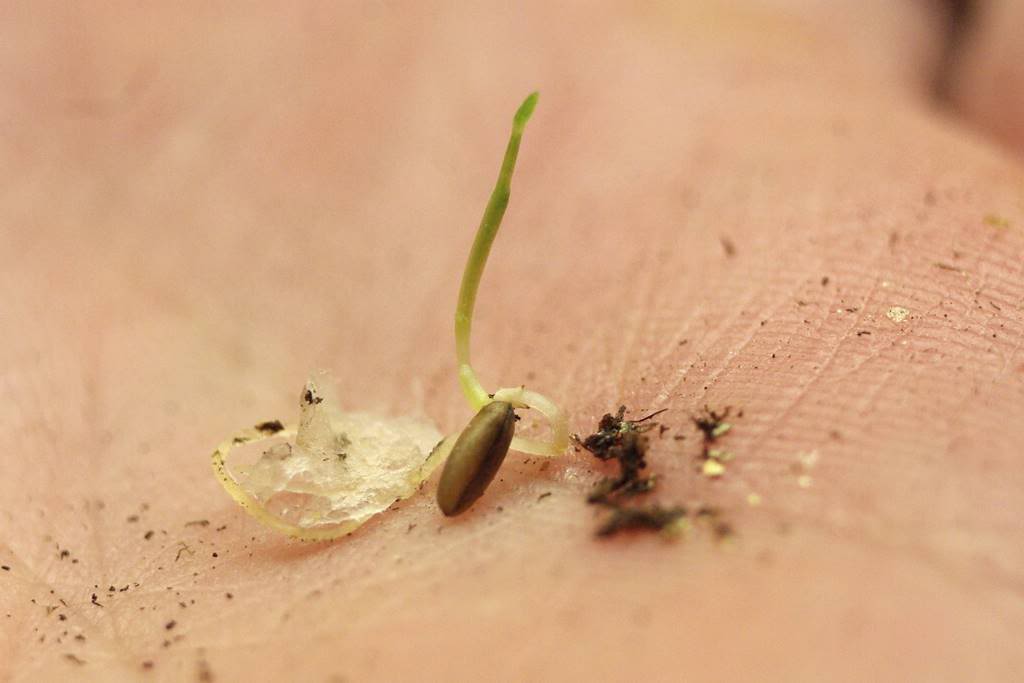If you're a regular reader, you know that I grow bamboo. In fact, like many who grow it, I'm a bit of a bamboo nut. I have plenty of bamboo plants of all sizes, both in-ground and in pots -- too many some may say. Still, when the opportunity to get some bamboo seed comes up, I can't say no!
Bamboo doesn't flower very often, with some species going 100 years or more before producing seeds, so it's not like you can just buy a packet of bamboo seeds whenever you want. When a species starts flowering though, often every plant of that species will flower (and usually die), so there may be a period of several years in which the seeds of a species are widely available. Such is the case right now, and I got some more seeds about a month ago and decided to give them a go.
I've tried growing bamboo seeds before, and never had much luck with germination. I received seeds of two different species this time, and put half of each into some damp potting mix and waited. (I like to keep some seed as backup in case something goes wrong.)
I waited for about 3 weeks before I gave up. That's the type of result I got last time I tried this.
Then the bamboo grower who sent me the seeds (thanks Steve!) said that he had good success with the damp paper towel in a baggie method, so I used the second half of the seeds this way.
Success! If you're not familiar with this method, it's simple -- just take a clean paper towel, dampen it, sprinkle on the seeds, fold in half, and place in a plastic baggie. Leave the bag slightly open for a small amount of airflow, and wait.
I only had to wait about a week before these Fargesia murielae seeds started germinating.
One thing you need to look out for is mold and other fungi, which may destroy some of your seeds:
There may be ways to prevent this, but since I had plenty of seeds and was only really interested in getting a couple of viable plants out of this, I wasn't too concerned and didn't want to make any extra effort researching or implementing mold-prevention measures.
These are large enough to put into potting mix now -- I'll use seed starting mix in six-packs.
They should be able to live in these small containers for a couple of months at least, and the convenience of having "one" object to move around is worth it for now. I've had dozens of individual seedling containers to handle before, and it's sometimes a lot of work.
So I gently lift the seedlings from the paper towel using a pointy toothpick, and carefully plant them in the mix. I don't pack the soil around the tender roots, instead relying on a gentle spray of water to settle the soil.
I noticed that a single seed from the original sowing (in the potting mix) has finally germinated:
The second species (Chusquea culeou) is also a clumping bamboo like the Fargesia murielae, but it probably won't be able to handle my climate very well. Still fun to try them though, right?
Some of these also germinated, although they took a few extra days:
A little mold problem here too.
But I still got six seedlings so far. Not bad, as I was expecting none!
When the root seems to be stuck to the paper towel, it's best to tear the paper using the toothpick instead of trying to pull the root free:
I used a different color of six-pack for this species, as they may look quite similar while young (or for a year or more):
Which leads me to another point about growing bamboo from seed: don't expect quick results. Even if these were the more vigorous running bamboo species, it would still take at least thee years before I had a plant that I would safely plant outside. With these clumpers I expect to wait at least two years before I have even a 1-gallon plant, which is pretty small for planting outside.
It's a bit like growing trees from seed -- it's fun and eventually pays off, but it's not for instant impact.
Still, it's exciting to get some new bamboo growing, even if they are about as small as they could be right now.
.












Alan, I've used the baggie method before with good success. But like you, I always have a problem with mold/fungi and inevitably lose most of my seedlings. Any ideas on how to stop it?
ReplyDeleteA little peroxide may avoid the mold. I'm going to try that.
DeleteBaby bamboo! Something I may never see again.
ReplyDeleteI never thought of germinating seed this way. I planted a bunch of seeds - most germinated and are growing well, a few did not. I'm going to try this with them.
ReplyDeleteGerhard: I wonder if a weak solution of neem oil would help? Do you lose the seedlings while still in the bag, or after transplanting?
ReplyDeleteI live in the tropics, where many bamboo species grow in the wild or in marginal areas. But i haven't seen flowering bamboos. Species that are very tall and strong used for construction aren't known to flower, or maybe they need special treatments to flower. This might be needed to breed them.
ReplyDeleteI haven't figured out a way to get rid of the mold problem either, but all I know is that once they start growing leaves and secondary roots, they start developing immunity to the mold.
ReplyDeleteI made a mistake of transplanting them too soon into my soil mix which was probably too much shock causing me to lose a lot of them, but when they have little green sprouts already, I think the success rate is probably a lot higher.
Andrea: or they flower once every 120 years or more?
ReplyDeleteSteve: these little seedlings are quite tough, so I'd be surprised if it was transplant shock. We'll see how mine are doing in a week or so though.
Hi,
ReplyDeleteWhere did you buy the seeds?
Greetings!
I didn't buy them -- I got them from another bamboo grower in the US. I don't think I'd ever buy bamboo seeds, because if there was a species I really wanted to grow I wouldn't want to wait the 5 years to get the seeds to a size that is worth looking at in my garden.
ReplyDeleteIn my country is inpossible to buy a plants, because they are not in stock :(
ReplyDeleteLucky you ;)
Greetings!